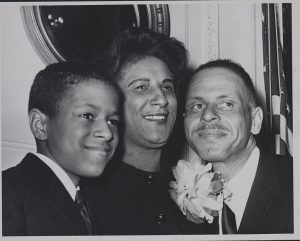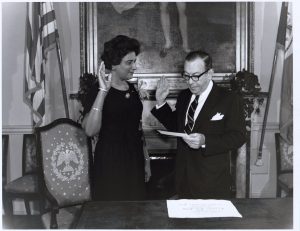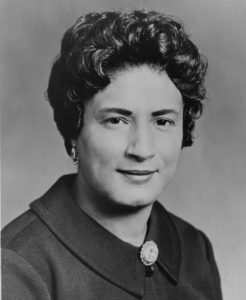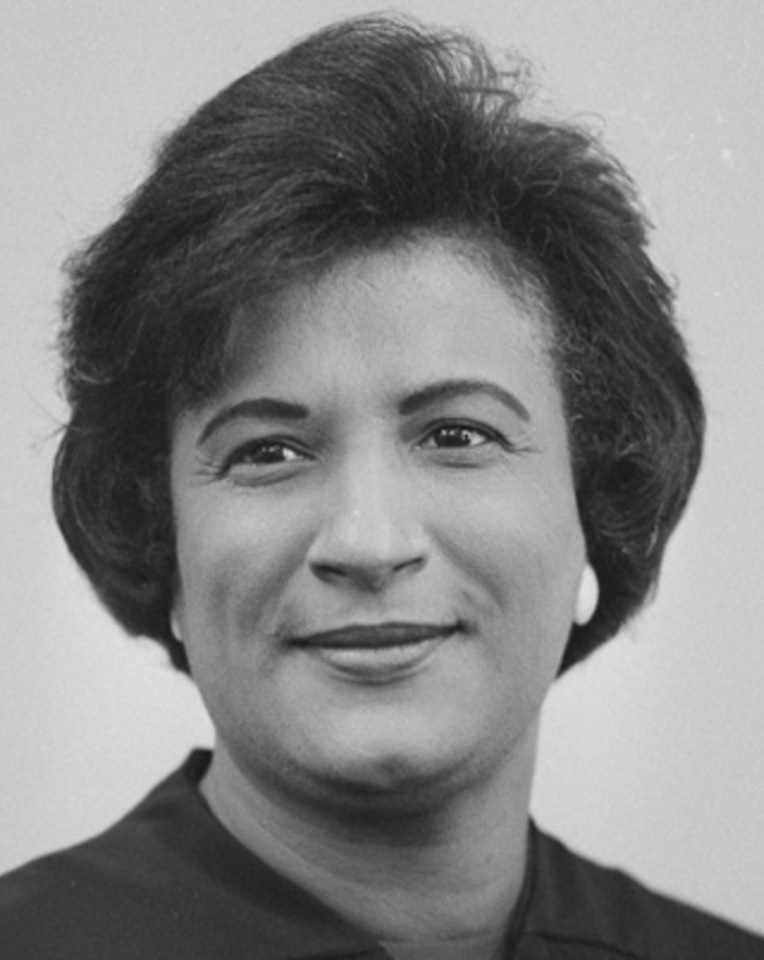Constance Baker Motley
Life Story: 1921-2005
The daughter of Caribbean immigrants who became a monumental civil rights advocate, pioneer in politics, and the first Black woman to argue before the Supreme Court and to serve as a federal district judge.
Background
Constance Juanita Baker was born on September 14, 1921 in New Haven, Connecticut. Her parents, Willoughby Baker and Rachel Huggins Baker, immigrated to the United States from the Caribbean island of Nevis. They were skilled workers who enjoyed a comfortable lifestyle. When they moved to the U.S., their financial and social statuses changed. The majority of Americans did not enjoy the prosperity of the “Roaring Twenties.” When the Great Depression hit in 1929, the situation grew worse, leaving 25 percent of the population unemployed. On top of that, the Bakers faced employment discrimination because of their race. With few other options, Willoughby became a chef at Yale University. Rachel, who had once hoped to be a teacher, became a homemaker. As a young girl, Constance felt her family’s financial strain. She and her eleven siblings depended on charity from local schools for school supplies and other necessities. Regardless of their financial situation, Willoughby and Rachel raised their children to believe they were special. The extended Baker family and West Indian community shielded the Baker children from the assumption of inferiority experienced by some Black Americans during this time period. The family support Constance experienced in her youth left her with confidence and a positive self-image that provided an internal strength and determination.
Education and Early Life
Unlike African-American students who lived in segregated communities, Constance attended integrated schools in New Haven, Connecticut and thrived. As a student, she studied W.E.B. DuBois, James Weldon, Abraham Lincoln, George W. Crawford, and Jane M. Bolin, and developed an interest in law and combating inequality. She earned excellent grades at Hillhouse High School, regarded as one of the country’s best schools, showcasing her intelligence. Outside of school, Constance volunteered with numerous community organizations. Her own experiences during the Great Depression inspired her to help those facing poverty. She joined the Connecticut Conference on Social and Labor Legislation, the New Haven Youth Council, and the Dixwell Community Center. The writing, public policy, and advocacy work she did with these groups would serve her throughout her life.
Upon graduation from Hillhouse in 1939, Constance found herself in a similar position to many Americans during the Great Depression, unemployed and with few job prospects. Fortunately, her volunteer work connected her with philanthropist Clarence W. Blakeslee. He was so impressed after hearing her speak that he agreed to fund her education. Within a few months, Constance enrolled at Fisk University, a historically Black college in Nashville, Tennessee. She attended Fisk for one year before transferring to New York University where she felt more at home. New York City felt more similar to New Haven. She lived in Harlem, an area known for its Black culture, and immersed herself in the community. An exceptional student, Constance was invited to join NYU’s prestigious pre-law honor society, Justinian. She graduated with honors in 1943 with a degree in economics and a minor in government.
Constance enrolled in Columbia Law School the following year. Enrollment was significantly down due to the number of men serving in the war, so Columbia admitted a larger number of women. Constance formed numerous friendships with women such as future New York congresswoman Bella Abzug and Elreta Alexander, who became the first Black female graduate from Columbia Law in 1945 (Constance was the second) and then a North Carolina judge. Despite her many friendships, Constance found Columbia an experience to tolerate rather than enjoy. Many of the professors felt the women didn’t belong, especially women of color. Numerous female students reported they did not find the Columbia Law School atmosphere to be accepting.

As World War II ended, women found it increasingly difficult to find work. Employers gave preference to men returning from war, diminishing the number of job opportunities for women. When Constance began her job search, she was turned away from several law firms. By chance, a fellow student shared he was leaving an internship with the Legal Defense Fund (LDF) of the NAACP. He suggested she apply for the position. She interviewed with future Supreme Court Justice Thurgood Marshall, aptly nicknamed “Mr. Civil Rights.” In October, Marshall offered Constance the internship during her second year of law school. After her graduation from Columbia in 1946, she earned a full-time position as a staff attorney.
During law school, Constance met Joel Wilson Motley, Jr., a real estate and insurance broker, who eventually became a partner at a successful Harlem firm. After dating for a year, the couple married shortly after her graduation on August 18, 1946. The Motleys had one son, Joel Wilson Motley III, and were married for 59 years.
Early Career
With the LDF, Constance focused on battling discrimination and establishing civil rights law. She assisted in fighting racially restrictive housing covenants in Michigan, Missouri, Ohio, Indiana, New York, and Georgia and challenging discrimination against Black veterans. For her first trial, Constance traveled to Jackson, Mississippi in 1949 to challenge racially discriminatory teacher salaries. Traveling through the segregated South, Constance, and her co-counsel Robert L. Carter, risked their lives and were subjected to racism. They struggled to find housing and places to eat. At trial, the appearance of two Black lawyers, one of whom was a woman, proved to be a sensational event. Constance Baker Motley lost her first case but her efforts mobilized African Americans in their fight for equality.
When she returned home to New York, Constance confronted her own wage disparity. Not only was she earning less than her male peers, she also was assigned fewer high-profile cases. She fought and won a raise and promotion to Assistant Special Counsel. Despite her victory, women continued to face gender inequality at the NAACP, LDF, and other civil rights organizations. Constance herself was passed over for a promotion in 1961 when Thurgood Marshall was nominated to the U.S. Court of Appeals for the Second Circuit and his position of Director-Counsel opened at the LDF. Her colleague Jack Greenberg was chosen instead.
In her new position, Constance played a vital role in preparing the LDF’s argument for Brown v. Board of Education (1954). The birth of her son in 1952 interrupted her work, but after only three months of leave, she returned to researching and drafting briefs for the case. She also drafted the model complaint that explained how segregation violated the Constitution that numerous attorneys copied with great success. When the Court handed down its unanimous decision declaring segregation in public schools unconstitutional, Constance shared the same joy as the other attorneys who had worked tirelessly on the case. She did not receive the same credit.
Supreme Court Advocate

Her involvement in Brown paved the way for several successful challenges to segregation in numerous public universities. The NAACP promoted her to lead counsel and continued to assign her significant civil rights cases. She became the first woman of color to argue before the Supreme Court in Hamilton v. Alabama (1961). Here, she effectively argued for the right to counsel when she persuaded a unanimous Court that her client’s rights had been violated when he was denied a lawyer. The following year, she represented James Meredith, a Black student denied admission to “Ole Miss,” the University of Mississippi. After numerous lower court proceedings and litigation, the U.S. Court of Appeals for the Fifth Circuit ruled in favor of Meredith, holding that the University violated his right to equal protection. The Supreme Court upheld the Fifth Circuit’s ruling. Though it took several attempts, and the assistance of the National Guard, Meredith eventually graduated from the University. Constance’s victory in the Meredith case led her to win similar desegregation cases at the university level in Florida, Oklahoma, Georgia, and South Carolina and helped put an end to massive resistance in the Deep South.
Constance also helped to desegregate public recreational facilities in the city of Memphis in 1963 (Watson v. City of Memphis) with a persuasive argument before the Supreme Court. The Court unanimously held that the segregated facilities were unconstitutional and must be immediately integrated. Memphis integrated some of the facilities, such as parks, but closed the city’s 54 swimming and wading pools. They remained closed for years. In 1963 and 1964, she successfully argued three cases that helped to end trespass prosecutions for sit-in demonstrators (Gober v. City of Birmingham, Bouie v. City of Columbia, and Hamm v. City of Rock Hill). In her last case before the Court, Justice Tom C. Clark’s majority opinion in Hamm overturned all convictions of all demonstrators participating in civil rights sit-ins. In total, Constance argued ten cases* before the Supreme Court between 1961 and1964 and won nine of them. The Court’s decision in the case she lost, Swain v. Alabama (1961), was overturned in 1986.

In addition to presenting cases before the Supreme Court, Constance represented Martin Luther King Jr. in several legal cases. She defended him in 1963 after he was arrested in Birmingham, Alabama and wrote “Letter from Birmingham Jail.” That same year, she also prevented the Birmingham school superintendent from expelling the 1,100 school children who participated in the Children’s Crusade. Her arguments persuaded the U.S. Court of Appeals for the Eleventh Circuit that the children could not be punished for protesting segregation and protected the children’s futures. She also secured the federal court order to protect the Selma Marchers after the infamous “Bloody Sunday” and joined the demonstration on March 25, 1965. As a result of these demonstrations, President Lyndon B. Johnson signed the Voting Rights Act of 1965 into law later that year. Constance Baker Motley’s tireless efforts during her 19-year career with the LDF earned her the nickname, “Civil Rights Queen.”
Series of Firsts

The first Black woman to argue before the Supreme Court was the first in a series of firsts for Constance Baker Motley. In 1964, she changed careers and became the first Black woman elected to the New York State Senate. Following in Senator Baker Motley’s footsteps, Shirley Chisholm won election to the New York State assembly the next year. Constance earned another first in 1965. She was elected Manhattan borough president and became the first woman to lead New York City. She served only a few months before President Johnson called with another opportunity.
A federal judicial vacancy opened in the United States District Court for the Southern District of New York. On a strong recommendation from Justice Tom C. Clark, who was impressed by her oral arguments before the Supreme Court, President Johnson appointed Constance Baker Motley to the judgeship in January 1966. Her nomination faced strong criticism from Mississippi Senator James Eastland who did his best to slow her confirmation, even accusing her of being a communist. She was officially confirmed on August 30, 1966—the first woman to serve as a United States District Judge. Judge Motley was sworn in on September 9.
Federal Judge
Judge Motley proved a hard-working, intelligent, and fair jurist. As the first female federal judge and a woman of color, Constance knew she faced additional scrutiny and skepticism. Her previous experiences as an attorney and a politician increased her awareness of the role of each branch of government and contributed to her judicious nature. Supremely professional on the bench, she exuded confidence. She never tolerated disrespect in her courtroom. In chambers, her law clerks considered her to be a compassionate and funny boss who demanded their best work while treating them like family.
In the courtroom, Constance played a key role in affirming the rights of the accused. In a 1969 Eighth Amendment case, Judge Motley found that the defendant’s solitary confinement was “physically harsh, destructive of morale, dehumanizing…needlessly degrading, and dangerous…” The decision helped to eliminate the “outrageously inhuman aspects of solitary confinement in some of the state prisons.”
In a few cases, Judge Motley’s opinions also helped to clarify gender equality, guaranteed by Title VII of the Civil Rights Act of 1964. In 1975, she was assigned Blank v. Sullivan & Cromwell, a class action lawsuit alleging that a prominent New York law firm was engaging in gender discrimination in its hiring practices. The lawsuit and its settlement forced a change in hiring practices and changed the workplace forever. It was a landmark decision for women hoping to be hired at larger law firms across the country. That same year, she heard Ludtke v. Kuhn. Her ruling revolutionized sports journalism for female reporters. She found that the New York Yankees violated Melissa Ludtke’s constitutional rights when the team refused to allow female reporters into the locker room. Judge Motley wrote the Yankees could easily protect players’ privacy without “maintaining the locker room as an all-male preserve.” “Let them [the baseball players] wear towels,” she declared. The U.S. Court of Appeals for the Second Circuit upheld her decision.
Judge Motley served as a federal District Court Judge until 1982 when she became the first woman appointed to Chief Judge of the Southern District of New York. She held the position until 1986 when she assumed Senior Status. Throughout her time on the bench, Constance was sensitive to her role as a federal judge and endeavored to enforce the rule of law and uphold the Constitution.
Legacy

Judge Constance Baker Motley died of a heart attack on September 28, 2005, two-weeks after her 84th birthday. She was still serving as a Senior Judge for her district. Constance broke barriers for women and people of color throughout her entire life. As an attorney, she advanced civil rights for Black Americans by ensuring their access to public facilities and higher education as well as their right to protest injustice. As a politician, she worked towards social change and better opportunities for people of color and those facing poverty. As a judge, she decided more than 2,500 cases. In an era where professional Black women faced discrimination, Constance fought for her achievements in the workplace. In her own words, she “was the kind of person who would not be put down…[and] rejected any notion that [her] race or sex would bar [her] success in life.” In 2001, President William Clinton awarded Constance the Presidential Citizens Medal. Constance Baker Motley is remembered as an extraordinary champion of civil rights and a highly-respected judge who inspired countless young women and people of color to pursue a career in the law and fight for equality.
Cases Constance Baker Motley Argued Before the Supreme Court
-
1961
Hamilton v. Alabama

The Supreme Court case that held accused persons have a right to counsel during the arraignment process in criminal proceedings.
-
1961
Swain v. Alabama

The Supreme Court’s decision that held that a defendant is not entitled to a jury with proportional representation to the defendant’s race.
-
1962
Turner v. City of Memphis

The Supreme Court’s decision that clarified racial discrimination to be unconstitutional in private businesses operating on federal land.
-
1963
Watson v. City of Memphis

The Supreme Court’s decision that held racial discrimination on public property to be in violation of the Fourteenth Amendment to the Constitution.
-
1963
Gober v. City of Birmingham

The Supreme Court’s decision that reversed the convictions of ten Black students convicted of trespassing during sit-in demonstrations.
-
1963
Shuttlesworth v. City of Birmingham

The Supreme Court’s decision that found an Alabama state statute that prohibited standing on a sidewalk in a way that blocks the free passage of others to be unconstitutional.
-
1963
Barr v. City of Columbia

The decision where the Supreme Court found the arrests and convictions of sit-in demonstrators to be in violation of the Fourteenth Amendment to the Constitution.
-
1964
Bouie v. City of Columbia, S.C. Lupper v. Arkansas

The third sit-in case where the Supreme Court found arrests of sit-in demonstrators to be unconstitutional by the Fourteenth Amendment.
-
1964
Hamm v. City of Rock Hill

The Supreme Court’s landmark decision that reversed the convictions of all sit-in demonstrators convicted of trespassing.
-
1964
Calhoun v. Latimer

The Supreme Court’s decision that required the Atlanta Board of Education to rewrite its school desegregation plan to assign school zones and teachers without regard to race.
Discussion Questions
- How did Constance’s upbringing and early life influence her career?
- How did being a woman impact Constance’s life and career?
- Which of the cases that Constance argued before the Supreme Court do you believe was most important? Explain.
- To what extent did Constance Baker Motley’s work help to end segregation? Justify your response with specific examples from the text.
- What can be learned from Constance’s many firsts? OR Which of Constance’s firsts do you believe was the most impactful? Explain.
- Constance said that she “I was the kind of person who would not be put down…I rejected any notion that my race or sex would bar my success in life.” How did she embody these words?
Extension Activity
Imagine you were an author writing the biography of Constance Baker Motley.
-
What would you title the book? Why?
-
How would you summarize her life for the brief description on the back cover?
-
What would you title the sections or chapters of the book? Why?
Sources
Special thanks to scholar and law professor Tomiko Brown-Nagin for her review, feedback, and additional information.
Baker Motley, Constance. Equal Justice Under Law: An Autobiography. New York: Farrar, Straus, and Giroux, 1998.
Brown-Nagin, Tomiko. Civil Rights Queen: Constance Baker Motley and the Struggle for Equality. New York: Vintage Books, 2022.
Feature Image: Constance Baker Motley, United State Circuit Court of Appeals for the Second Circuit.
Ford, Gary L. Constance Baker Motley: One Woman’s Fight for Civil Rights and Equal Justice Under Law. Tuscaloosa, Alabama: The University of Alabama Press, 2017
Williams, Ann Claire. She Lifted Her Voice, Judicature 103 3: 79-82 (2019).
Featured image: Portrait of Judge Constance Baker Motley. Courtesy of the United States Court of Appeals for the Second Circuit.
